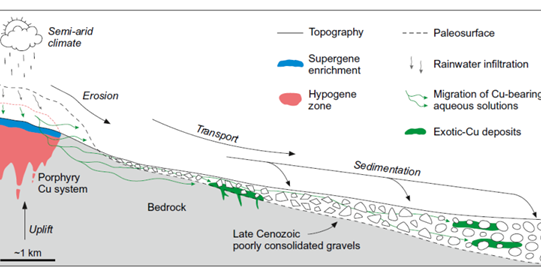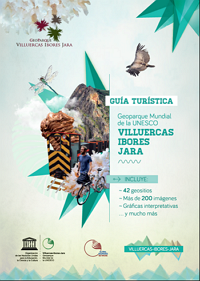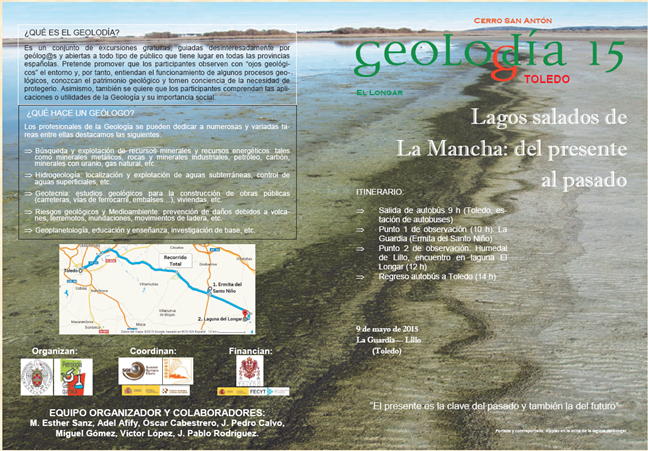HERITAGE AND GEOLOGICAL RESOURCES IN CONTINENTAL SEDIMENTARY ROCKS
|
Description |
Our research is focused to the knowledge of the spatio-temporal evolution of our planet surface. We study fundamentally chemical and biochemical sedimentary rocks whose formation involves interactions with the biogeochemical cycles. The applications are varied:
1) Knowledge of the Geological Heritage for its conservation and dissemination.
2) Geological resources: hydrocarbons, water, industrial materials, etc.
3) Sustainability of the planet: knowledge of the past helps to predicting the future.

Distribution model of Cu deposits (Atacama, Chile)
|
How does it work |

Tourist guide of the Villuercas Ibores Jara Geopark
The geological heritage (geological places with high scientific, cultural and / or educational interest) is a type of social resource with economic interest since it can also be used as a touristic (recreational) and informative resource.
Our work focuses on continental sedimentary rocks that contain many geological resources (metals, rocks and industrial minerals, water, hydrocarbons, etc.) and have, in many cases, a great tourist interest (karstic caves, wetlands, carbonate buidups in waterfalls, etc.).
The continental sedimentary rocks represent a large percentage of the surface of the Spanish territory and its geotechnical behavior is generally complicated (evaporites, karstified rocks, etc.) which makes the realization of public works very difficult and expensive.
The sedimentary rocks (carbonates and evaporites, mainly) record a good part of the history of our planet (climate, biology and hydrochemistry) and, therefore, are the key to understanding the future.
|
Advantages |
These studies have direct application in the environmental awareness, conservation and sustainable exploitation of relevant geological features (Geoheritage). Relevant geological areas, in many cases, are located in rural regions that, thus, can be benefited from geotourism.
The knowledge of the processes of formation and transformation of the rocks allows knowing how and where the geological resources of mineral, hydrothermal and geothermal origin are concentrated (simplifying their location and exploitation); it also helps to understand its geotechnical behavior (optimizing the implementation of civil works), especially in the case of evaporites, and assessing their interest as CO2 sinks.
|
Where has it been developed |
Our research focuses mainly on chemical and biochemical sedimentary rocks, which are generated in all types of continental environments, both recent and fossil such as: soils, lakes, karst systems, fluvio-lacustrine systems and hydrothermal water vents. The studies are being developed in the Iberian Peninsula and in the Canary Islands, as well as in other continents: America (Chile -Atacama-, Argentina-Patagonia - Uruguay), Asia (China) and Africa (Egypt).
Research in Spain is located, in many cases, in protected areas with different level of protection, for example, Castañar Geopark, Lillo wetland (nature reserve and biosphere reserve), Coca-Olmedo wetland, etc. In addition, it is relevant that some of the ancient sedimentary systems studied, contain mineral exploitations of Fe (Egypt) or Cu (Chile). Others include exploitable industrial rocks (travertines, gypsum, limestone, clays, etc.)

Excursion guide of the Lillo wetland.
|
And also |
The group participates in the:
- Preparation of the catalog of Geological Interest Places (LIG) and participates continuously in activities to publicize Geology as a science for society, among others:
- Geolodia.
- Semana de la Ciencia (Week of Science).
- Geological Olympiad.
- Edition of books and scientific journals.
- Preparation of geological reports and maps.
- Participation in national and international scientific networks.
|
Contact |
|
© Office for the Transfer of Research Results – UCM |
|
PDF Downloads |
|
Clasification |
|
Responsible Researcher |
M. Esther Sanz Montero: mesanz@ucm.es
Department: Mineralogy and Petrology
Faculty: Geology


